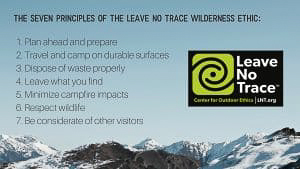Discovering the Importance of LNT Principals
By: Kimball Stewart
With well over 5 million people visiting Yosemite National Park this past year, understanding an individual’s impact on the land is critical. Like with all of our protected lands, we love Yosemite because it offers us a taste of the wilderness—or at least of the environment unscathed by human activity. Of course, Yosemite is not wholly un-impacted by people. Anyone who sets foot in the valley knows this. There are roads, hotels, traffic jams, dumpsters, and honking horns. With such high visitation, it’s hard to find utter solitude and a landscape that is truly untrammeled by people. For most visitors, simply being in the presence of such massive natural features like El Capitan or Half Dome is enough to inspire a sense of connection with the natural surroundings. Recognizing and encouraging in people this sense of connection is vitally important if we want future generations to be able to enjoy the earth’s wild spaces like we do.
My own environmental stewardship is rooted in an understanding of my personal impact on the land. During my various excursions in the outdoors, my appreciation for wild places has been guided by a set of wilderness ethics often referred to as Leave No Trace, or LNT. Based on a list of seven guidelines, the concept of LNT is intended to help minimize our impact on the places that we use. I was first introduced to the Leave No Trace principle when I was 16, while traveling through the Wyoming backcountry. I remember initially thinking that the seven guidelines seemed unnecessary. Was it really that important to pick up the peanut I had accidently dropped? Afterall, I was deep in the wilderness—miles from any road—in an area where I doubted anyone else would ever set foot. How was a single peanut going to impact this land, let alone someone else’s experience in it? If the trail I was hiking on had a large puddle of mud in its center, couldn’t I just walk around it? Would my individual steps actually cause the trail to widen and erode?

| Over time, however, I learned to appreciate what the Leave No Trace principles were all about. While my own individual actions might not leave a noticeable impact on the land, they would certainly leave an impact over time. If I made a small campfire ring every night that I camped in the backcountry it wouldn’t take long for that to leave a noticeable and lasting impression on the land—regardless of how remote I was. Plus, I quickly realized that if everyone dismissed their own actions as insignificant the overall impact would be massive. When traveling in a group, everyone’s personal actions are multiplied which can lead to effects far more wide-reaching than anticipated. Think about it: if all twelve members of a hiking group camped in an alpine meadow instead of on a durable surface, the impact would be visible by morning. Or, if every person who visited the top of Vernal Falls (or even 10 percent!) tossed their apple core into the forested area behind them, a gargantuan pile of rotting apple cores would accumulate rapidly. The lasting effect would be an unpleasant stench for all the future visitors, an aggressive and unhealthy gang of squirrels and other “wild” critters, and an ecosystem that would struggle to regain normalcy. |
As someone who spends a great deal of time hiking and camping throughout Yosemite, I understand and appreciate the fragility of the park given the millions of visitors it sees each year. The task of keeping the park wild and pristine is daunting, and some might argue that it’s not even possible. But it’s a critical endeavor. By focusing our attention on minimizing the impact we have on our surroundings, we can create a sense of environmental stewardship and help protect an invaluable public resource.

Learning and practicing the Leave No Trace wilderness ethics isn’t something that needs to happen exclusively in wilderness or rural settings. Try incorporating the principles into your everyday life at home. By slowly forcing yourself to become aware of your impact on things around you, you will realize where you’re being wasteful and the corresponding effects this has. By simply following the first principle “Plan Ahead and Prepare” you will find yourself using a reusable water bottle instead of buying a disposable one when caught thirsty when out and about. Developing the attitude of an environmental steward requires time and practice. Most importantly, however, it requires effective training. If you are interested in becoming an expert in environmental stewardship and the Leave No Trace principles, consider signing up for Lasting Adventures’ 27-day Yosemite Leadership Expedition. During this intensive wilderness excursion you will have the opportunity to earn your official Leave No Trace certification. There is no time like the present to start developing attitudes that will last a lifetime!
For more information on our 28-day expedition visit 2017 Lasting Adventures Yosemite Leadership Expedition
For more information on the Leave No Trace principles, visit their website: Leave No Trace
– Happy Hiking –

